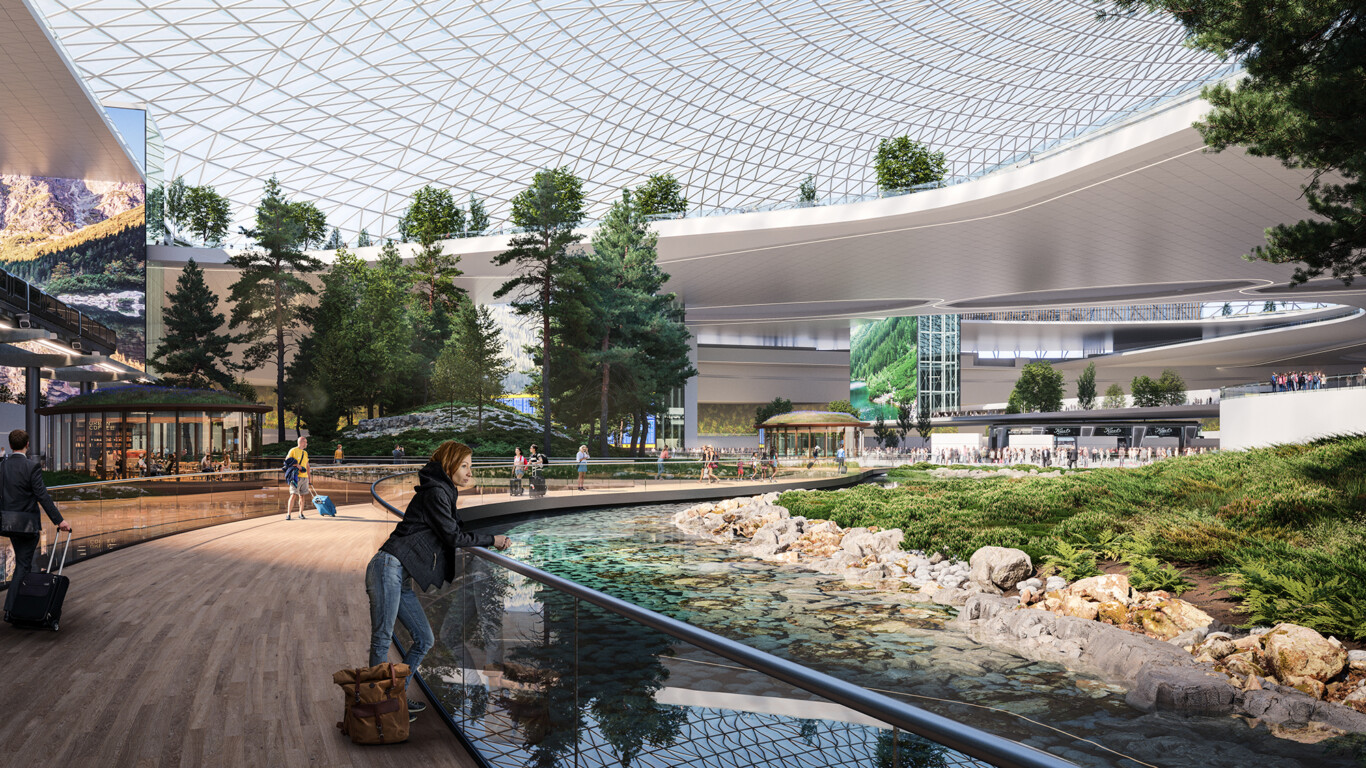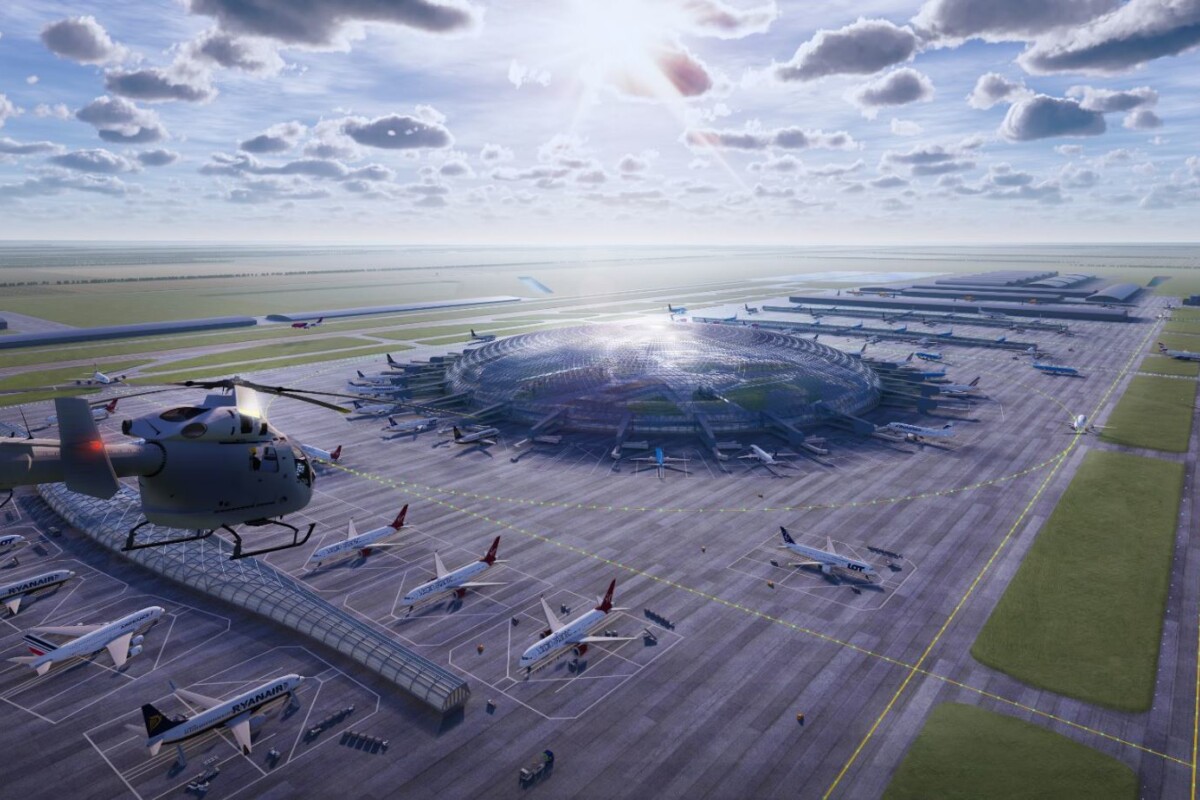Project Profile: Rethinking airport and railway station design at Solidarity Transport Hub
Chapman Taylor has created an innovative concept design for the proposed new Central Transportation Hub (CPK) between Warsaw and Łódź in Poland, called Solidarity Transport Hub, which is due to serve as a major multi-modal aviation and railway interchange serving 45 million passengers annually when it opens in 2027. In his Insight paper on the topic, Transportation Director Peter Farmer describes key elements of the design which will ensure Solidarity Transport Hub is prepared for advances in transport technology and the advent of personal drone travel. He also describes a step away from traditional airport design thinking when it comes to surface access and provision for private cars. In this Q&A, we ask Peter to elaborate further on these innovations and to explain the rationale behind them.
There has been some comment about the innovative proposal at Solidarity Transport Hub to remove kerbsides from the terminal’s immediate interface. What inspired this new surface access philosophy?
For decades, it has been an unchallenged assumption in airport planning to set aside a quarter or more of a terminal’s edge to serve the dominance of the private car.
For the Solidarity Hub, we felt that this was an assumption which should be questioned for a number of reasons – the key ones being:
· The Hub is designed to facilitate the unification of Polish rail, becoming part of a network of new or existing parkway interchange stations. We therefore wanted to encourage the use of trains as the main mode of access to the Hub.
· Restricting the movement of aircraft around an airfield to facilitate surface access for cars reduces airfield efficiency and increases ground movement. The model we have adopted is more efficient and sustainable.
· Removing the interface also helps with some key security and management issues, although it only displaces, rather than eliminates, car access.
Car access will be routed to an airfield edge location, similar to the excellent business parking and pod shuttle offer at London Heathrow’s Terminal 5, while taxis will have similar facilities or, for a limited number of services, a below-ground interchange between the rail and airport levels.
Could you expand on the idea for a network of parkway stations?
This is not a new idea, but is ideally suited to the Solidarity Hub concept. The environments around many airports suffer from the concentration of surface access towards the airport – primarily private transport, in the form of cars, but also taxis and buses.
Given the rail connections at the Hub, we proposed establishing a far-reaching network of parkway stations. Instead of travelling, say, 50, 60 or 100 kilometres to the airport, a passenger would instead travel, say, 10 kilometres to their local parkway and transfer to a limited-stop train service to the heart of the Hub complex.
The parkway station, or the train itself, could offer services such as check-in, baggage processing, immigration and security pre-checks, travel services and, in the current COVID-19 context, even pre-boarding health checks. Arriving at the airport, it could be possible for passengers to move directly airside (post-security) or remain landside and take advantage of the unique range of offers and attractions at the Solidarity Hub.
We must recognise that the cultural obsession with private car ownership is lessening and that to maintain a transport model dependent upon it would be short-sighted. However, we do appreciate that this is a bold step.
In your Insight paper, you mentioned designing for future transport types. Could you expand on this?
Future-proofing is crucial for the longevity and relevance of this new transport environment. There are several emerging technologies that could impact airports and railways stations in the future and there are likely to be new concepts emerging during the gestation period of the Solidarity Hub. We are designing with driverless cars, eVTOL (electric vertical-take-off-and-landing) or piloted drones and hyperloop trains in mind, to give just three examples.
Driverless cars will be managed in a similar way to today’s private cars and taxis; a key advantage of their use will be their predictability and the ease with which they can be managed. We have proposed that Personal Air Vehicles (PAVs) in the form of, for example, eVTOLs will be managed to one side of the airfield, between the runways, and that passengers will then transfer to the main facility via a shuttle. We consider it very important to ensure that these vehicles do not compromise main airfield operations.
The Hyperloop concept is extremely interesting and we clearly integrate it with the rail element. The development of the rail-level ‘box’ in our proposals will be significantly oversized and flexible, as evidence shows that not doing so leads to disproportionate costs when introducing new connections and services later. We have built in sufficient flexibility to easily allow the introduction of future rail and Hyperloop connectivity.
What is the relationship between the rail and aviation elements?
This is a complex and multi-faceted subject. For us, the rail connectivity is the really exciting aspect of this venture. A truly integrated rail and airport environment provides opportunities for unification, alternative and wider connection opportunities, more sustainable connections and the development of an interchange that has all of the excitement and vibrancy of both train and air travel in one accessible human setting. It could be an environment which isn’t dominated by post-security provisions, instead being accessible and relaxing, with a seamless and stress-free transition to a safe aviation or rail journey.
Chapman Taylor’s Transportation team has successfully designed and delivered transport-related projects at some of the most famous passenger environments in the world. Our collaborative design approach brings together a range of specialisms to fulfil all the requirements of these increasingly complex schemes. We understand the functional and commercial needs of airports, railway stations and integrated hubs, including their future-proofing, as well as being at the cutting edge of research and thinking about how to turn them into flexible and commercially successful destinations in their own right.
There has been some comment about the innovative proposal at Solidarity Transport Hub to remove kerbsides from the terminal’s immediate interface. What inspired this new surface access philosophy?
For decades, it has been an unchallenged assumption in airport planning to set aside a quarter or more of a terminal’s edge to serve the dominance of the private car.
For the Solidarity Hub, we felt that this was an assumption which should be questioned for a number of reasons – the key ones being:
· The Hub is designed to facilitate the unification of Polish rail, becoming part of a network of new or existing parkway interchange stations. We therefore wanted to encourage the use of trains as the main mode of access to the Hub.
· Restricting the movement of aircraft around an airfield to facilitate surface access for cars reduces airfield efficiency and increases ground movement. The model we have adopted is more efficient and sustainable.
· Removing the interface also helps with some key security and management issues, although it only displaces, rather than eliminates, car access.
Car access will be routed to an airfield edge location, similar to the excellent business parking and pod shuttle offer at London Heathrow’s Terminal 5, while taxis will have similar facilities or, for a limited number of services, a below-ground interchange between the rail and airport levels.
Could you expand on the idea for a network of parkway stations?
This is not a new idea, but is ideally suited to the Solidarity Hub concept. The environments around many airports suffer from the concentration of surface access towards the airport – primarily private transport, in the form of cars, but also taxis and buses.
Given the rail connections at the Hub, we proposed establishing a far-reaching network of parkway stations. Instead of travelling, say, 50, 60 or 100 kilometres to the airport, a passenger would instead travel, say, 10 kilometres to their local parkway and transfer to a limited-stop train service to the heart of the Hub complex.
The parkway station, or the train itself, could offer services such as check-in, baggage processing, immigration and security pre-checks, travel services and, in the current COVID-19 context, even pre-boarding health checks. Arriving at the airport, it could be possible for passengers to move directly airside (post-security) or remain landside and take advantage of the unique range of offers and attractions at the Solidarity Hub.
We must recognise that the cultural obsession with private car ownership is lessening and that to maintain a transport model dependent upon it would be short-sighted. However, we do appreciate that this is a bold step.
In your Insight paper, you mentioned designing for future transport types. Could you expand on this?
Future-proofing is crucial for the longevity and relevance of this new transport environment. There are several emerging technologies that could impact airports and railways stations in the future and there are likely to be new concepts emerging during the gestation period of the Solidarity Hub. We are designing with driverless cars, eVTOL (electric vertical-take-off-and-landing) or piloted drones and hyperloop trains in mind, to give just three examples.
Driverless cars will be managed in a similar way to today’s private cars and taxis; a key advantage of their use will be their predictability and the ease with which they can be managed. We have proposed that Personal Air Vehicles (PAVs) in the form of, for example, eVTOLs will be managed to one side of the airfield, between the runways, and that passengers will then transfer to the main facility via a shuttle. We consider it very important to ensure that these vehicles do not compromise main airfield operations.
The Hyperloop concept is extremely interesting and we clearly integrate it with the rail element. The development of the rail-level ‘box’ in our proposals will be significantly oversized and flexible, as evidence shows that not doing so leads to disproportionate costs when introducing new connections and services later. We have built in sufficient flexibility to easily allow the introduction of future rail and Hyperloop connectivity.
What is the relationship between the rail and aviation elements?
This is a complex and multi-faceted subject. For us, the rail connectivity is the really exciting aspect of this venture. A truly integrated rail and airport environment provides opportunities for unification, alternative and wider connection opportunities, more sustainable connections and the development of an interchange that has all of the excitement and vibrancy of both train and air travel in one accessible human setting. It could be an environment which isn’t dominated by post-security provisions, instead being accessible and relaxing, with a seamless and stress-free transition to a safe aviation or rail journey.
Chapman Taylor’s Transportation team has successfully designed and delivered transport-related projects at some of the most famous passenger environments in the world. Our collaborative design approach brings together a range of specialisms to fulfil all the requirements of these increasingly complex schemes. We understand the functional and commercial needs of airports, railway stations and integrated hubs, including their future-proofing, as well as being at the cutting edge of research and thinking about how to turn them into flexible and commercially successful destinations in their own right.

